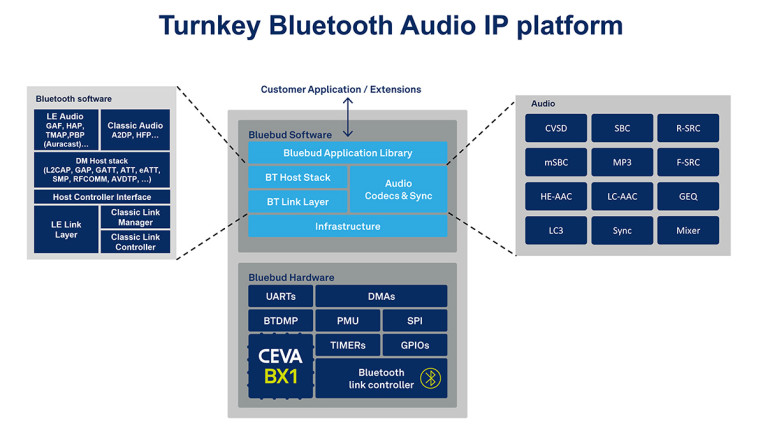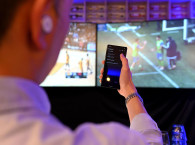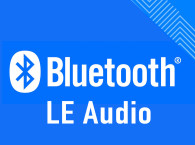The recently published market update from the Bluetooth Special Interest Group (SIG) forecasts that Bluetooth audio streaming device shipments will grow at a 7% CAGR to reach 1.8 billion annually by 2026, with earbud shipments growing by a factor of three in that time.

While Bluetooth dominates the consumer wireless audio market, it has some limitations – it doesn’t have native support for audio streaming to true wireless stereo (TWS) earbuds, and it is only a one-to-one technology, with no capabilities to broadcast audio to multiple devices. With TWS set to be the biggest market for Bluetooth in audio, expected to reach 850 million units shipped annually by 2026, this is a problem for device vendors.
Now, these issues have been addressed by the Bluetooth SIG, in its recently-announced Auracast standard. This new audio sharing standard, based on the Bluetooth Low Energy (LE) Audio broadcasting specification, enables a single Auracast transmitter device, such as a smartphone or TV, to broadcast one or more audio streams to an unlimited number of Auracast receiver devices, such as TWS earbuds, speakers or hearing aids.
Previously known as Bluetooth Audio Sharing, Auracast is set to transform the shared audio experience. It will open up significant new opportunities for innovation, including personal and location-based audio sharing.
Potential use cases include flight-specific audio broadcasts at an airport, multiple TV channels being shown in a gym, or multi-language options at a museum. Anywhere there is a TV in a public space, Auracast will make it easier to hear what is being shown – which will often be as simple as just scanning a QR code on the wall with your phone. You’ll also be able to easily share music, or audio from a movie you’re watching, with your friends.
For people with hearing loss, audio in public spaces can be broadcast directly to Bluetooth hearing aids and cochlear implants. This provides a high quality, affordable alternative to traditional inductive loop systems.

Bluetooth Audio Variants and Auracast
In today’s Bluetooth audio solutions, everything is based on point-to-point links: with one source device using Bluetooth to stream audio to one "sink" or recipient device, which could be a mono or stereo headset, for example.
The older Bluetooth "Classic" standard can support a data rate of up to 3Mbps. For voice quality audio, for example for phone calls, the hands free profile (HPF) is ideal, while the A2DP profile delivers higher quality for music, when desired.
With TWS earbuds becoming so popular, device vendors have a problem: Bluetooth Classic does not natively support TWS. This means the vendor requires some proprietary technology for the TWS earbuds, such as packet forwarding or sniffing. These techniques do not make optimum use of the data bandwidth available, and typically mean one of the earbuds is connected to the audio source, and then either forwards the audio to the other earbud, or exchange link parameters with the other earbud so that it can also receive the same audio directly from the source.
Instead, the more recent LE Audio specification (based on Bluetooth LE) now natively supports TWS, and specifically can provide dual stream audio – where both earbuds are connected directly to the phone or other audio source. Dual stream is the best technical solution in terms of minimizing power consumption and latency.
Auracast is based on the LE Audio specification, which is built upon the Bluetooth 5.2 Isochronous Channels feature. By 2026, Bluetooth LE is expected to account for 43% of total Bluetooth shipments, and will be dominant in headsets, hearing aids, and hearables. To ensure backwards compatibility with the huge installed based Bluetooth Classic devices, the remainder of the market is likely to be Bluetooth Dual Mode, which includes compatibility with both Classic and LE.
LE Audio brings interesting new capabilities, that Auracast takes full advantage of: lower power consumption, synchronized multichannel audio (for stereo, or surround sound such as 5.1), and support for one-to-many audio broadcasting. CEVA has contributed to the evolution of the Bluetooth standard and has licensed its Bluetooth LE and Dual Mode technologies, including Auracast solutions, to major semiconductor companies and OEMs for various applications including wireless headsets, TWS earbuds, hearing aids, smart watches, speakers and microphones.

Designing with Auracast
To enable the broadcast capability of Auracast, there is an additional software layer, called the Generic Audio Framework, which sits on top of the existing Bluetooth LE protocol stack. This additional layer is a collection of services and profiles required for broadcast audio.
The Auracast transmitter device does not need to know which receiver devices are connected to it. The objective is to make everything as simple as possible for the consumer, and access to Auracast may be from a straightforward menu, possibly shown on your phone’s home screen.
For more recent devices, such as high-end smartphones, it will be possible to upgrade the device’s software to support Auracast. Additionally, to enable audio sharing with older Bluetooth Classic devices, it is possible to use an Auracast bridge, which has an A2DP receiver on one side, and an Auracast transmitter on the other side.
Auracast is a new specification, so it is not yet clear how quickly it will roll out, and when Auracast audio streams will be available in public places – although it’s reasonable to expect this will start to happen within a year or so.
Benefits of an Auracast Platform
For OEMS looking to add Auracast support, the challenges and technical issues can be problematic, and successful implementation is likely to be difficult and complex. Expertise is required in both the Bluetooth and audio domains, and it can be challenging to design a product that has both high audio quality and low power consumption.
Audio is an area where consumers are likely to be sensitive to any minor product imperfections – for example, if the left and right audio in your earbuds is not properly synchronized, you will notice immediately, and the listening experience is no longer so enjoyable. Achieving good synchronization is not easy, requiring accurate timing information, and the ability to cope with clocks in the left and right earbuds that drift apart as they run at very slightly different frequencies.
Vendors need to minimize latency to 20µs or less, as above this, listeners start to notice a difference, which translates into the listener thinking the sound is now coming from a different direction. 3D audio is another potentially tricky application, as head movement must be tracked with very low latency, so the sound can respond to the listener’s movement.
To overcome any technical challenges, as well as to reduce time to market and cut risks, it can be beneficial to work with an IP provider who can offer a turnkey solution. For instance, CEVA’s latest RivieraWaves Bluetooth 5.3 IP family now supports Auracast. CEVA offers both Bluetooth LE and Dual Mode IP platforms, including baseband controller, radio and full software protocol stack, compliant with Bluetooth 5.3, Classic Audio, LE Audio, and Auracast.

Also, to simplify the development of wireless audio devices, CEVA’s Bluebud Bluetooth audio turnkey platform combines Bluetooth, audio, and sensing IPs in a single, integrated solution. To make it suitable for TWS earbuds and hearing aids, it includes a comprehensive list of audio codecs, including LC3, (m)SBC, CVSD, AAC, MP3, voice processing algorithms such as ClearVox for noise reduction and echo cancellation, WhisPro for speech recognition, and MotionEngine Hear for Spatial Audio and motion sensing (which is an important part of the user interface for earbuds and other hearables with no buttons or screen).
Conclusion
Auracast is a big step forward for Bluetooth audio, and promises to be convenient for users, and capable of delivering high audio quality. It fully supports TWS earbuds, and its broadcast capabilities will enable new applications. Consumer products that support Auracast are expected to be available by the end of 2022.
While implementing Auracast is likely to be complex, using a turnkey platform can reduce risk, accelerate time to market, and cut development costs. With the platform handling Auracast, an OEM can concentrate on the differentiators of their product.
 About the Author
About the AuthorFranz Dugand is the Senior Director of Sales & Marketing, Wireless IoT BU at CEVA. Franz Dugand is in charge of expanding the CEVA Bluetooth, Wi-Fi, UWB and NB-IoT product lines into various market segments such as mobile, consumer electronics, gateway, healthcare, automotive, industrial, and other IoT applications.
This article was originally published in The Audio Voice newsletter, (#388), August 18, 2022.






